by Winding Pathways | Sep 22, 2017 | Mammals, Nature
Many landowners face challenges caused by abundant deer. This animal evolved under heavy predation by wolves, bears, mountain lions, and Native American hunters. Their survival strategy, in addition to being well camouflaged and fleet, is to have many babies. A healthy doe normally bears one fawn when she is just one year old and twins or triplets in subsequent years. Wild predators have been extirpated but deer continue to reproduce at a rapid rate. When they are too numerous, over browsing of crops, trees, shrubs, and wildflowers devastates ecosystems. Deer numbers need to be kept in balance with their habitat to protect natural beauty and devastation.
Modern hunting is an effective substitute for predators. Deer hunting is popular but many hunters, or potential hunters, lack a place to hunt. Many landowners suffer deer damage but don’t hunt.
Successful match making between hunters and landowners can work toward their mutual benefit. However, the relationship is most successful when hunters are managed by the landowners with expectations clearly articulated BEFORE permission is granted to access property.
Most hunters are ethical but they sometimes stretch understandings, especially verbal ones. For example, if a landowner gives permission for one person to hunt, he/she sometimes assumes that gives them license to invite their relatives or friends to hunt the property. And, they may assume that this is perpetual permission and that they can hunt any species at any legal time without additional permission. Also, to control deer populations it is essential to harvest does, yet many hunters seek only big bucks. Landowners using hunting as a management tool may need to insist that does be taken.
Attached is a sheet of expectations that a landowner might present to anyone wishing to hunt. It articulates expectations and clarifies the relationship between landowner and hunter.
HUNTING PERMISSION FORM
to be presented to person seeking permission to hunt
I, (name of hunter)_______________________________understand that I am being given permission to hunt on the property of
(name of landowner)____________________________________________. In exchange for this privilege I agree to abide by the following understandings:
- I will abide by all local, state, and federal game laws and will be properly licensed to pursue the species and gender of animal the landowner is allowing me to hunt.
- I understand that permission is granted only to me and that this does not extend to relatives or friends unless the landowner specifically grants them permission.
- Permission is granted to hunt only the following animals:
Species: _____________________________________________________________________________
Gender: _____________________________________________________________________________
- Permission is granted to only use the following weapons:
- Permission is granted to only hunt the following seasons or dates:
- Permission to hunt is for this year only and must be renewed in future years.
- I will not erect stands or blinds any earlier than one week before the start of the season. I will remove blinds, stands, and anything else I brought on the property within one week of the end of the season.
- I will not put nails, screws, or any other metal objects in trees.
- I will inform the owner of animals I harvest.
- I will treat the land with respect and will hunt in a safe and ethical manner.
- I will provide the landowner with meat if requested.
Hunter’s name Printed______________________________________
Address_____________________________________________________
email address_______________________________________________
Phone_______________________________________________________
Signature of Hunter__________________________________________________ Landowner________________________________________________________________
Vehicle that will be parked near or on landowner’s property:
Make_______________________Model______________________
License number__________________________________________
by Winding Pathways | Sep 21, 2017 | (Sub)Urban Homesteading, Mammals, Nature
This week Winding Pathways will feature two blogs that cover the “ins and outs” of harvesting deer, landowner responsibilities and a sample agreement between landowners and deer hunters. This blog includes The Law, Equipment, and Ways to Process a Deer. The next blog on this topic will cover how landowners can manage hunters on their land and a sample agreement form.
Eating Deer
Frustrated homeowners often discover their landscape plants, flowers, and vegetables devoured by hungry urban and suburban deer.
Although we can find them annoying, deer are amazing. Deer are resourceful and adaptable. In many rural areas, their former habitat has been transformed into seas of corn, soybeans, or other crops. The hedgerows, woodlots, and brushy patches that once offered deer shelter have disappeared. So, they moved into town.
Many suburban and even urban areas offer a perfect place for deer to live. Parks and protected natural areas have secure places to live, and vegetable gardens, flower beds, and fruit trees are outstanding deer food. It’s no wonder so many towns are home to robust deer herds.
Although most people love seeing wildlife and enjoy having a few deer around when the garden is raided attitudes change quickly. In response, Winding Pathways and many garden books and blogs offer tips on how to protect trees and plants from hungry deer. Some hardly work, while others, especially secure fencing around gardens, keep deer out. Unfortunately keeping the hungry animals at bay is a never-ending and sometimes expensive task.
Many gardeners are proud to produce local organic vegetables. They might consider the deer that raid their garden a local, organic, free-ranging source of delicious meat. When done according to state and local laws, converting a deer to family food in no way threatens deer herds. They rapidly reproduce, making deer a perpetual and sustainable food source.
Killing, dressing, and preparing deer meat is an unknown and somewhat mysterious process for suburbanites who have no experience with bows or firearms or converting a live animal to a meal. This blog will give them a basic idea how to do it.
To us shooting a deer is food gathering, much like picking spring nettles or mulberries. We view deer as an opportunity to harvest local, organic, free-range meat.
The Law
In the United States wildlife does not belong to a private landowner. It is the property of the people – all the people. Some wildlife protection laws are set by the Federal Government but individual states have the most responsibility for setting and enforcing laws that protect wildlife yet allow people to harvest certain species. Hunting is an important tool in reducing overabundant game species, such as deer.
Anyone wishing to harvest a deer must heed the laws of the state they live in. Generally, this means purchasing a license and hunting certain types of animals only during open seasons. The type of weapon used is also specified by the state.
Traditionally towns and cities have banned hunting and shooting of any sort for safety reasons. However burgeoning deer numbers and resulting vegetation damage and car collisions encouraged town councils to relook at their ordinances. Many have altered ordinances to allow citizens to harvest deer, even in fairly densely populated (by people) areas. State laws always apply and cities normally add their own regulations, mostly to ensure the safety of residents.
Our town of Cedar Rapids is a good example. People are allowed to buy licenses to harvest deer within city limits using bows and arrows if they:
- Attend a training session
- Prove proficiency with archery equipment
- Purchase tags and licenses
- Bring harvested deer to a fire station for officials to check
- Use only permitted weapons during legal seasons
- Inform neighbors of hunting
- And several other specific requirements.
Hunting has reduced, but hardly eliminated, vegetation damage and deer/car collisions. It has put thousands of pounds of nutritious meat on the tables of many families.
So, if anyone wants to harvest a deer they should first check with their city or town to see if it is legal and what specific requirements are in place.
Generally, anyone living outside city limits and a distance from neighbors only needs to abide by state hunting laws. These tend to be much less restrictive than urban or suburban hunting. Check your state’s Department of Natural Resources for information. Normally deer hunting regulations are posted online.
Two Ways to Harvest a Deer on Your Property
There are essentially two ways to convert a garden devouring deer to steaks, burgers, and chops. They are:
- Inviting a hunter to shoot a deer on your property. This eliminates the need to own a weapon, shoot an animal, and skin, dress and package it. It’s the easy way for most people but it’s not always simple. See the related Winding Pathways Blog on Tips for managing hunters on your land. Salespeople in local sporting goods stores can help locate a bowhunter. Landowners should request that their hunter provide them with some wrapped and frozen meat.
- Do it yourself. The rest of this blog is general information on how to shoot, process, and eat a deer.
DEER HUNTING EQUIPMENT
There are generally four types of devices legal and effective for killing a deer. A brief description follows:
BOW AND ARROW: Archery is the favored and often only legal way to kill a deer in cities and towns. Skilled archers are amazingly effective in quickly killing a deer. Unlike firearms bows are quiet. Arrows have a very limited range with 40 yards being about the maximum. It requires hunters to be close to their quarry. Usually, bowhunters place a stand up in a tree. Deer rarely look up when roaming around and often come close to archers perched high. Also, being in a tree requires a downward shot toward the ground. The shooting angle and limited range make archery a safe hunting method in areas of dense human population. It is not easy and skilled archers spend many hours throughout the year practicing to be accurate shots. An upside is that archery is fun. Many people enjoy target shooting, and this can be combined with bow hunting.
SHOTGUNS: Often states require firearm hunters to use shotguns in areas with dense human populations. Shotguns discharge either a single projectile called a “slug”, or a few large diameter pellets, called “buckshot”. Most states require hunters to use slugs. These tend to be heavy and relatively low in velocity. When fired from a smoothbore shotgun they are accurate only at a range of 50 yards or so. Newer rifled barreled shotguns using slugs made for them are more accurate and can humanely kill a deer at 125 yards or even longer. Deer slugs tend to not travel a long distance so are commonly mandated near towns.
RIFLES: High powered rifles are generally only allowed in areas of low human density away from cities. In the hands of a competent person, they are very accurate at a much longer range than shotguns. Rifles come in a wide range of calibers that launch bullets of different weights and velocities. It gets complicated, but generally, rifles aren’t allowed or used in places where the human density is high.
MUZZLELOADING RIFLES: Before cartridge rifles were invented muzzleloading rifles were the norm. These require loading powder and bullet from the bore or end of the barrel. It is a somewhat slow process and muzzleloaders are single shot since it takes a while to reload. Generally, muzzleloaders shoot large heavy bullets at a slower velocity than cartridge rifles. They can be very accurate at relatively short range. Winding Pathways is outside city limits and we use a muzzleloader to take a deer on our property each year.
An excellent way to learn how to safely and effectively shoot a firearm is to locate a local shooting range or sporting goods store that sells firearms. Many offer training and excellent information. Our next-door neighbor at Winding Pathways owns a nearby store called Cedar Valley Outfitters. It holds regular firearms training classes and will arrange private lessons to help novices learn how to safely handle and accurately shoot a firearm. Unlike big box stores that sell firearms smaller locally owned gun stores are likely to offer training. A resource to help locate a store or shooting range is the National Shooting Sports Foundation.
PREPARING TO HUNT A DEER
Think a year ahead. It will likely take that long for a novice to decide to convert a deer to food, research the local and state laws, purchase an appropriate bow or firearm, and learn to shoot it accurately. Finding a mentor may speed the process.
WHAT TO DO ONCE THE DEER IS ON THE GROUND
The easiest way to process a deer is to take it to a locker and pay a professional butcher to covert the carcass into cuts. Most also will grind it or process it into sausage of many types.
Butchering a deer at home is not hard. It takes us about three hours to convert a carcass to cuts of wrapped meat in the freezer.
Hunters normally eviscerate a deer immediately after shooting it. This makes the carcass lighter to transport and helps it cool quicker. The best way to learn how to do this is to tag along with an experienced hunter and learn first-hand. YouTube Videos also show how to do it. It is important to cool meat quickly to prevent spoilage. At Winding Pathways, we quickly bring a freshly killed deer to our garage where we have a simple block and tackle that lets us hang the deer by its hind legs. This allows us to easily skin and eviscerate it. Once completed we wash the carcass with water and cover it with a clean sheet to keep dirt and insects away from the meat. If the weather is cool – in the mid to high 30s or 40s – we let the meat age for a couple of days before cutting it into pieces ready for the freezer.
BUTCHERING
A veteran meat cutter is the best instructor to show how to cut a deer into steaks, roasts, chops, stew meat. Because our freezer is small we bone out all the meat. We prepare a few roasts and several steaks but much of the deer is cut up into chunks for stew or put into great-grandma’s old hand cranked grinder and converted to ground meat. We can fit a butchered medium-sized deer into our small freezer and eat it throughout the winter.
Many YouTube videos show how to skin, butcher, and freeze deer meat. Some include cooking tips. One of the better ones is called FIELD DRESSING, SKINNING, BUTCHERING TO FREEZING-LARGE GAME PROCESSING-DEER.
COOKING AND EATING DEER
When properly processed and cooked deer meat is delicious. It is very lean so tends to be somewhat drier than beef. Many people make the mistake of overcooking venison. We cook it to the same degree of doneness as we would a similar piece of beef. Most of our venison is chunks used in winter stew or ground meat used in place of beef hamburger in chili, spaghetti sauce, and many other dishes.
by Winding Pathways | Sep 18, 2017 | Bugs, Nature
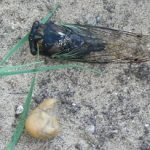
Bumper year for cicadas.
As summer winds down, our warm weather has continued in the upper Midwest and insects are having a heyday. Cicadas still call and Katydids make quite a racket at night. Behind all these summer sounds is the high pitched “cheek-cheek-cheek” of crickets. Mosquitoes persist as do any number of tiny biting insects the gravitate to open skin.
Several interesting and helpful insects, however, capture our attention. Donna, a walker on Rich’s “100th Circuit” walk around Cedar Lake shared pictures of the Digger Wasps in her yard. What fascinating insects!
Grasshoppers and Praying Mantis catch our eye because the first can hop incredible distances and the second has such an unusual shape and seem to appear only this time of year. The ubiquitous Asian Lady Beetles that bite and stink and Box Elder Bugs so aptly described as having “no where to go and all day to get there” are massing to enter our warm homes for the winter.
-
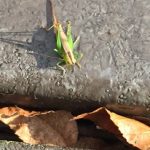
-
Grasshoppers are considered among “…the oldest living group of chewing herbivorous insects.”
-
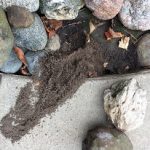
-
The Digger Wasp makes and then covers over tunnels.
-
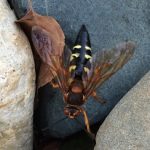
-
Digger Wasps are benign insects.
-
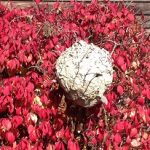
-
Camouflaged all summer, this nest now stands out against the red foliage.
-
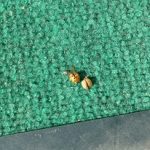
-
These “pretender” lady bugs invade homes each fall.
-
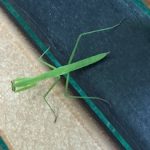
-
Praying Mantis live in temperate and tropical climates.
Winding Pathways invites readers to take a few minutes to learn about and then go out and observe these fascinating denizens of late summer and early fall. You Tube has great videos of these insects and we’ve cited several sources above. We even learned that people can and do eat some of these crunchier critters.
by Winding Pathways | Sep 14, 2017 | Bugs, Nature
Every once in a while an enormous wolf spider startles us when we go downstairs and flip on a light. We call him “Wolfie”. Fortunately, most of the time he (Wolfie might be a she) stays out of sight and is helpful because (s)he eats other critters that inhabit homes with humans.
Spiders are just about everywhere. At least 45,700 species have been identified with new ones found every year. Of all orders of living things spiders are seventh in total diversity. They live on all continents except Antarctica and in nearly every habitat except the air and salt water. Too many myths surround spiders and the stories grow around October – Halloween month. Actually, August and September in many parts of the US are prime arachnids months.
Spiders are in everyone’s home and yard. Most are tiny, harmless to humans and stay out of sight. We are most aware of spiders in the yard on mornings after a heavy dew when the lawns are carpeted with ” fairy napkins.” This is the work of funnel spiders that eat pesky insects.
All spiders share common features. Although often called “bugs” or insects spiders are arachnids that have eight legs. Insects have but six. All spiders, with possibly one exception, are carnivorous. They kill prey, which often is insects, with venom.
While we think of all spiders as predators, they themselves are an important prey species for other animals. Spot a warbler or brown creeper working its way along a tree and it’s probably seeking tiny spiders hidden in cracks in the bark or on leaves. For many birds a spider meal is simply delicious.
Spiders live in houses for good reason -food and shelter! It’s a wild world outside and plenty of insects, usually tiny and unseen, share the house with humans. They provide spiders with food. Houses are full of cracks and crevasses, perfect places for both insects and spiders to hide. Basements are usually humid, creating a perfect environment for small creatures, and when cold weather comes the furnace warms people and the insects and spiders that share the house.
Everyone has heard about Black Widow and Brown Recluse Spiders. These species can pose a health threat to people, but they are shy and rarely encountered especially in the upper Midwest.

Spider bites are painful.
Other spider species might also bite and inject venom. While not deadly, these bits can be uncomfortable Once after we returned from having been gone from the house for several days, Marion got nailed on her legs by a spide . She donned a pair of pants that had been hanging in a closet. Perhaps sensing a lack of activity, and finding the pants a comfy place to live, a spider had taken up residence in them. When disturbed by Marion’s putting on the pants, the spider defended itself by biting.
A doctor visit confirmed the bites. Antibiotics took care of the swelling and stinging. But, even two months later the healed over skin shows the discoloration of the bites. So, we did use spray to control any more arachnids from making themselves too comfortable in our home.
Late summer and fall are the best seasons to enjoy beautiful spider webs. At Winding Pathways, we often are graced by gorgeous intricate vertical webs strung between tall prairie grass. When dew covered in early morning, they are wondrous structures. Shelf spiders make horizontal webs, often on lawn grass, to trap insects. Our favorite, “Hawkeye” spider, really the black and yellow garden spider, weaves an orb web and makes short work of pesky garden insects. “Skinny-legged” spiders that often perch high in corners of rooms are harmless to people and keep insects that fly in open doors well at hand by trapping and eating them. Although webs are the most visible evidence of spiders many species don’t make them and rely on stealth and speed to catch prey directly.
Many people fear spiders, but they are remarkable, common and amazing animals that help keep insect numbers muted and usually don’t create problems for people.
-
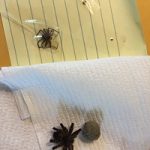
-
Arachnids around us
-
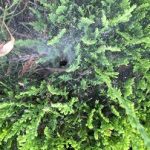
-
This beneficial spider controls insects in the yard.
by Winding Pathways | Aug 17, 2017 | Nature
A creative family on 29th St. Drive SE decorated an old Stump over a period of months. The stump even survived the first round of construction and then, had to go. It’s kind of sad because the stumps livened up our drives to and from work. So, here is a memory lane and thanks to the creative person who was so dedicated in cheering us up and keeping us up to date on the seasons and cultural activities we all love so much.
-
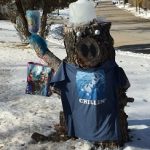
-
Frozen
-
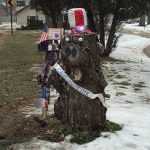
-
Caucus
-
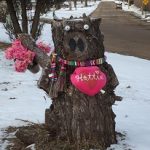
-
Valentines’ Day
-
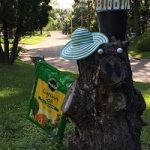
-
Gardening
-
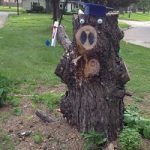
-
Graduation
-
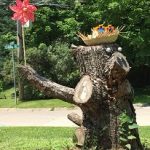
-
Summer!
-
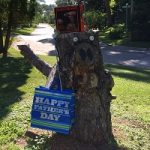
-
Fathers’ Day
-
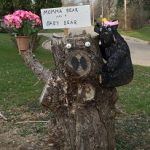
-
Baby is born!
-
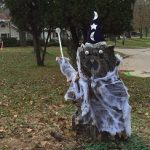
-
Halloween
-

-
Veterans’ Day
-
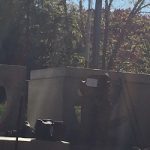
-
Construction begins
-
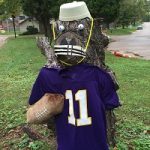
-
Football!
-
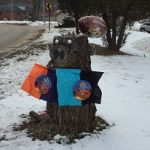
-
Superbowl
by Winding Pathways | Aug 4, 2017 | Nature, Travel/Columns

A picture perfect day to canoe.
On a splendid late July day we packed up food, loaded the canoe, paddles and life jackets and headed out to explore the Odessa Water Trail. It’s one of Iowa’s several water trails and part of a larger system of water trails in the Midwest. What a blast!
Two hours south of Cedar Rapids the The Odessa Trail in Louisa County offers a way to explore backwaters safely. It winds through two wildlife management areas. The map we picked up at the Port Louisa National Wildlife Refuge Headquarters ensured we would not get lost in the maze of channels that form the meandering floodplain. Tucked in the inner elbow below Iowa’s bulge with the “Father of Waters” this refuge, managed for waterfowl and wildlife, encompasses 6400 acres and sports three tails ranging from an easy three mile paddle to a moderate 4.5 mile cruise to a 6.5 trek that can extend to 17 miles!
The Refuge closes from mid-September to January first to accommodate migratory waterfowl. Other times it is open to boaters, canoeists and kayakers, fishermen, and birders. Hiking and bicycling trails line the main islands, but those adventures could be dicey in high water and just plain buggy in hot weather. A campground is conveniently located near the Odessa Wildlife Unit Headquarters.
This day was just right. High pressure kept winds down, the sun was warm, but the air cool, especially for July. Sunscreen, long sleeved shirts and hats kept the sun’s rays at bay. Mid summer is quiet for bird life after their busy nesting season. Still we heard and saw a variety of songbirds and kept annoying a Great Egret and at least two Great Blue Herons. They would nervously watch us approach then with a loud squawk lift off and wing a few hundred yards down stream. Only to be annoyed again, when we approached. We did watch a heron catch and swallow a fish.
Along the banks frogs of all sizes croaked and leapt into the murky water. Lots of fish were rising up, but Rich decided not to wet his line, and rather studied the trail map carefully as we floated and paddled. Partway down, we pulled in for lunch balancing snacks in the canoe as the day drifted by.
It was great to try out one of Iowa’s many water trails. Check out the link to the National Park’s National Water Trail System. And, enjoy the short videos and photo gallery below. Go Outside and Play!
Great Egret Flies Off Click this link to see.
Great Blue Heron fishes.
-
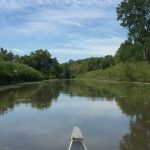
-
Access to the trail is a canal that slows into the Mississippi River.
-
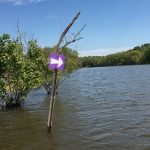
-
Odessa Water Trail is well marked.
-
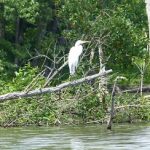
-
Eyeing us.
-
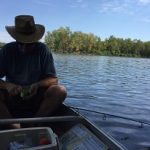
-
In the shade.
-
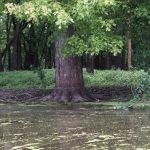
-
Tell tale signs
-
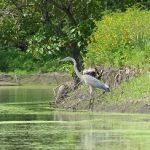
-
Great Blue Heron
-

-
Harbinger of changing weather.
-
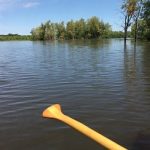
-
Silver Maples beginning to turn.
































